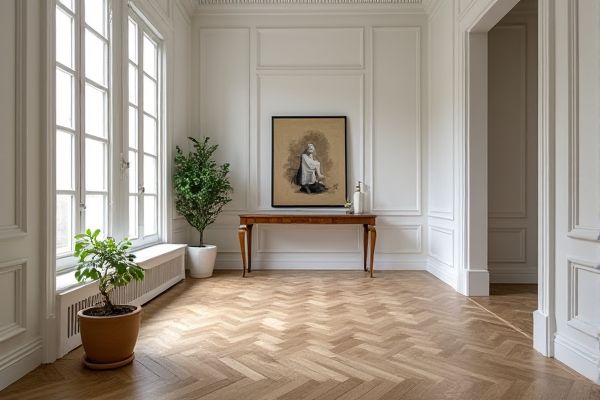
Herringbone pattern features a broken zigzag design with rectangular pieces laid at right angles, creating a more textured and traditional look, while chevron pattern consists of continuous V-shaped lines with end-to-end pieces forming a seamless, modern appearance. Discover which pattern suits Your style and space by reading the rest of the article.
Table of Comparison
| Feature | Herringbone Pattern | Chevron Pattern |
|---|---|---|
| Design | Rectangular tiles arranged in a staggered zigzag pattern | V-shaped pattern with tiles cut at an angle to form a continuous zigzag |
| Appearance | Interlocking, broken zigzags creating a brick-like effect | Sharp, seamless zigzag with symmetrical points |
| Installation | Requires precise alignment of rectangular pieces | Needs angled cuts for each piece to create the chevron shape |
| Common Uses | Flooring, backsplashes, textiles, and wall decor | Flooring, fabrics, wallpapers, and graphic design |
| Visual Effect | Dynamic movement with a subtle, classic look | Bold, continuous zigzag that draws strong attention |
| Complexity | Moderate complexity | Higher due to angled cuts and precision |
| Historical Origin | Ancient Roman road paving and tile work | French military insignia, named after a V-shaped rank mark |
Introduction to Herringbone and Chevron Patterns
Herringbone and chevron patterns are popular geometric designs widely used in flooring, textiles, and interior decor for their visually appealing zigzag effects. Herringbone consists of rectangular pieces arranged in a staggered zigzag pattern resembling fish bones, while chevron features angled pieces that meet to form a continuous V shape. Understanding the differences between these patterns helps you choose the right style to enhance your space's aesthetic and texture.
Origins and Historical Background
The Herringbone pattern originated in Ancient Roman architecture, commonly used in road paving and masonry for its interlocking V-shaped design that provided durability. The Chevron pattern dates back to heraldic designs found in medieval Europe, symbolizing rank and protection with its continuous angular zigzag shape. Your choice between these patterns reflects a blend of historical craftsmanship and stylistic variation rooted in centuries of decorative and functional applications.
Visual Differences: Herringbone vs Chevron
The herringbone pattern features rectangular tiles arranged in a staggered zigzag design, creating a broken or offset "V" shape with distinct, sharp angles between pieces. In contrast, the chevron pattern uses tiles cut at the ends to form continuous "V" shapes with perfectly aligned angles, resulting in a seamless, arrow-like appearance. Visually, herringbone provides a more textured, dynamic look, while chevron offers a uniform, streamlined effect.
Installation Techniques Compared
Herringbone pattern installation involves aligning rectangular tiles or planks at a 45-degree angle in a staggered zigzag layout, requiring precise cutting and spacing to ensure seamless joints. Chevron pattern installation uses tiles or planks cut at angles (typically 45 degrees) to form a continuous V shape, demanding meticulous angle accuracy for the interlocking points. Your choice influences the complexity of cuts and alignment precision, with herringbone suited for straightforward rectangular layouts and chevron requiring more intricate angled cuts.
Material Options for Both Patterns
Herringbone and chevron patterns offer versatile material options including wood, tile, and vinyl, each providing unique textures and finishes that enhance design aesthetics. Wood herringbone often features oak or walnut, prized for durability and rich grain, while chevron can highlight precision cuts in ceramic and porcelain tiles for sleek, modern looks. Vinyl versions of both patterns cater to budget-friendly, easy-to-install solutions with water-resistant properties suitable for high-traffic areas.
Aesthetic Impact in Interior Design
Herringbone patterns create a timeless, textured aesthetic with a subtle zigzag effect that adds depth and sophistication to flooring or wall designs. Chevron patterns offer a more dynamic, continuous V-shaped motif that draws the eye and introduces a bold, modern statement in your interior space. Choosing between these patterns depends on whether you want a classic, intricate look or a striking, seamless architectural element.
Durability and Maintenance
The Herringbone pattern, composed of rectangular tiles arranged in a zigzag formation, offers superior durability due to its interlocking design that evenly distributes weight and reduces wear. The Chevron pattern, featuring angled cuts creating a continuous V shape, tends to show wear more quickly along the angled joints, requiring more frequent inspections and maintenance. Maintenance for Herringbone is generally easier, as dirt and scratches are less noticeable along its staggered lines, while Chevron patterns demand more careful cleaning to preserve their sharp, seamless appearance.
Cost Implications and Budget Considerations
Herringbone patterns typically involve more complex installation due to angled cuts, resulting in higher labor costs compared to the chevron pattern, which has a consistent V-shaped design that can streamline production and reduce expenses. Choosing between these two patterns depends on your budget, as herringbone may require more precise craftsmanship and time, increasing overall project costs. Factoring in material waste and installation duration will help determine the most cost-effective option for your flooring or wall design project.
Best Applications for Each Pattern
The herringbone pattern is best suited for flooring and backsplashes where a classic, timeless look with subtle texture is desired, often enhancing hallways and living rooms. Chevron patterns excel in modern spaces such as feature walls and textiles, providing a bold, dynamic visual impact due to their continuous zigzag design. Both patterns offer versatile applications, but herringbone works better for traditional or rustic aesthetics, while chevron complements contemporary and minimalist interiors.
Choosing the Right Pattern for Your Space
Selecting the ideal flooring design depends on room size, style, and desired visual impact; herringbone patterns create a dynamic, staggered effect suited for traditional or rustic interiors, enhancing texture and depth. Chevron patterns offer a sleek, continuous zigzag line that works well in modern or minimalist spaces, emphasizing symmetry and movement. Consider natural light, furniture layout, and overall decor to ensure the pattern complements rather than overwhelms your space.
 homyna.com
homyna.com